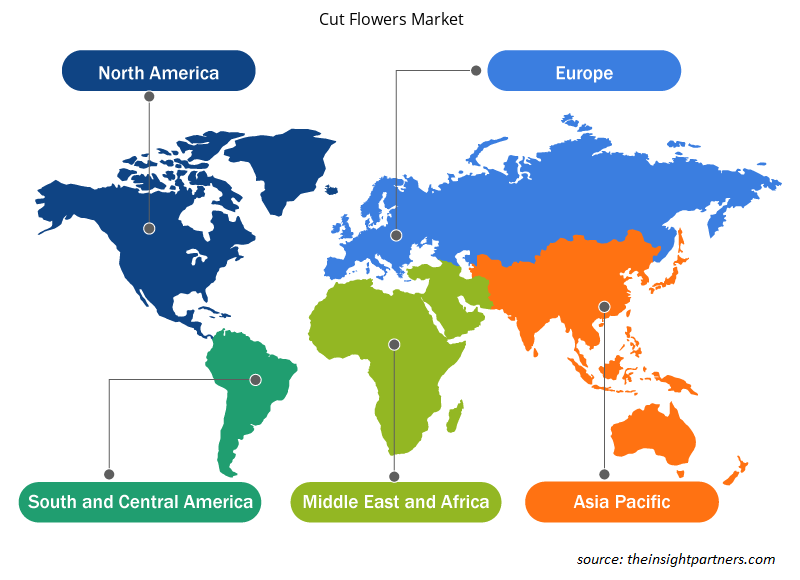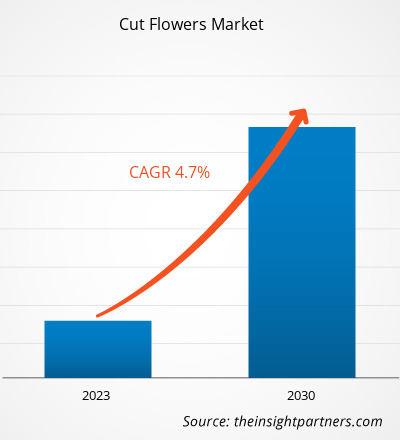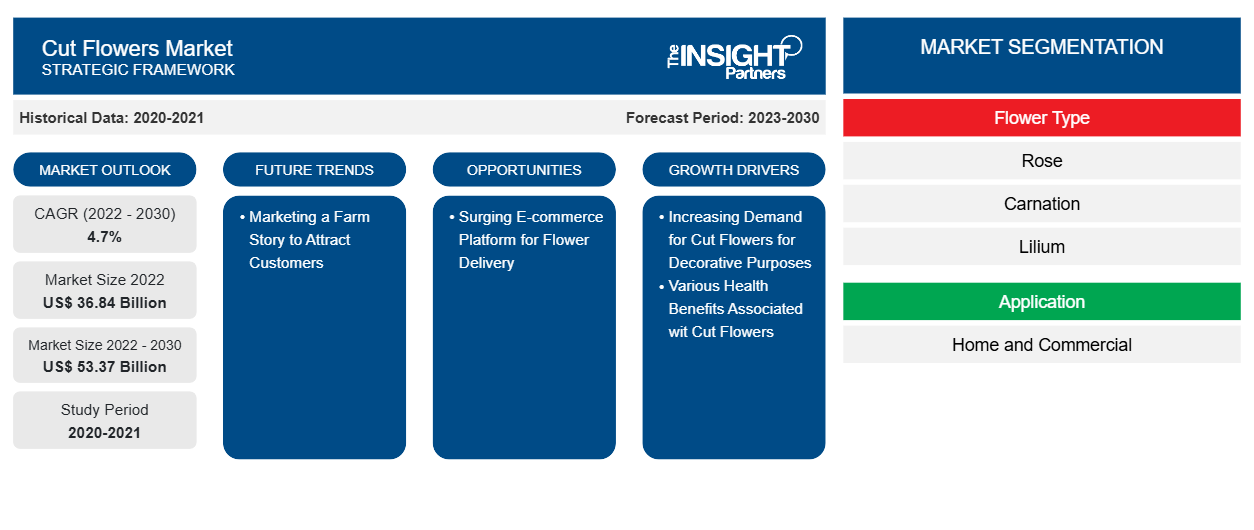[Informe de investigación] Se proyecta que el tamaño del mercado de flores cortadas crecerá de US$ 36.835,42 millones en 2022 a US$ 53.369,13 millones en 2030; se espera que el mercado registre una CAGR del 4,7% de 2022 a 2030.
Perspectivas del mercado y opinión de analistas:
Las flores cortadas son flores o capullos que se cortan de la planta en la que crecen. Por lo general, se extraen de las plantas para su uso con fines decorativos. La mayoría de los jardineros cosechan sus flores cortadas en sus jardines, pero la mayoría de los países tienen una industria floral dedicada a las flores cortadas. Las plantas de las que se cortan las flores cortadas varían según el clima, la cultura y el nivel de riqueza local. En su mayoría, las plantas para flores cortadas se cultivan en campos o invernaderos separados. El cultivo de flores cortadas es intensivo, ya que requiere grandes cantidades de pesticidas y residuos altamente tóxicos.
Factores impulsores del crecimiento y desafíos:
Las flores cortadas se utilizan con fines decorativos. Se utilizan en arreglos florales y ramos en eventos formales y exhibiciones informales para embellecer hogares y lugares públicos, diseños para bodas y funerales, ramilletes, coronas, artículos ornamentales similares y ramilletes. Los organizadores de eventos y bodas utilizan diversas flores para la decoración, ramos y centros de mesa, creando espacios creativos para eventos. Según el estudio Knot Real Wedding, el costo promedio de inversión en flores para bodas fue de US$ 2400 en 2022. Además, la creciente demanda de flores exóticas y de temporada para la decoración floral para mejorar la estética del espacio por parte de los organizadores de eventos y bodas ha contribuido aún más al crecimiento del mercado.
Las flores cortadas se utilizan con fines medicinales debido a sus diversos beneficios para la salud. Se sabe que las flores tienen un impacto inmediato en el estado de ánimo. Sus colores vibrantes y fragancias agradables pueden ayudar a reducir el estrés, la ansiedad y la depresión, mejorando el bienestar mental. Los estudios han demostrado que las flores pueden reducir los niveles de cortisol (una hormona del estrés), lo que conduce a una disminución del estrés y una sonrisa más relajada. Por ejemplo, un estudio realizado por la Facultad de Medicina de Harvard demostró que cuando se tienen flores en casa, las personas se sienten menos preocupadas, lo que reduce la ansiedad y la depresión.
Las flores cortadas están sujetas a diversos requisitos legales y no legales. El comercio internacional de flores cortadas a menudo implica una documentación importante, que incluye certificación fitosanitaria , declaración de aduanas y permisos. El estricto cumplimiento de estos requisitos es necesario para el comercio transfronterizo. Por ejemplo, los requisitos fitosanitarios de los compradores , el etiquetado de los productos y los requisitos de embalaje deben seguirse estrictamente en los países europeos. La Unión Europea ha establecido requisitos fitosanitarios para detener la propagación e introducción de productos vegetales nocivos para los organismos en la región. Las flores cortadas exportadas a la UE deben cumplir con la legislación de la UE sobre sanidad vegetal. La mayoría de las flores importadas a la Unión Europea deben ir acompañadas de un " certificado fitosanitario " oficial, que garantice que las condiciones fitosanitarias de las plantas y los productos vegetales y el envío han sido inspeccionados oficialmente. Debe cumplir con los requisitos legales para la entrada en la Unión Europea y estar libre de plagas de cuarentena y otros patógenos nocivos.
Personalice este informe según sus necesidades
Obtendrá personalización en cualquier informe, sin cargo, incluidas partes de este informe o análisis a nivel de país, paquete de datos de Excel, así como también grandes ofertas y descuentos para empresas emergentes y universidades.
-
Obtenga las principales tendencias clave del mercado de este informe.Esta muestra GRATUITA incluirá análisis de datos, desde tendencias del mercado hasta estimaciones y pronósticos.
Segmentación y alcance del informe:
El mercado mundial de flores cortadas está segmentado en función del tipo de flor, la aplicación, el canal de distribución y la geografía. Según el tipo de flor, el mercado de flores cortadas se segmenta en rosas, claveles, lirios, crisantemos y gerberas, entre otros. Según la aplicación, el mercado se bifurca en doméstico y comercial. Según el canal de distribución, el mercado de flores cortadas se segmenta en supermercados e hipermercados, tiendas especializadas/floristerías, venta minorista en línea y otros. Geográficamente, el mercado está segmentado en América del Norte (EE. UU., Canadá y México), Europa (Alemania, Francia, Italia, Reino Unido, Rusia y el resto de Europa), Asia Pacífico (Australia, China, Japón, India, Corea del Sur y el resto de Asia Pacífico), Oriente Medio y África (Sudáfrica, Arabia Saudita, Emiratos Árabes Unidos y el resto de Oriente Medio y África) y América del Sur y Central (Brasil, Argentina y el resto de América del Sur y Central).
Análisis segmental:
Según la aplicación, el mercado de flores cortadas se divide en doméstico y comercial. El segmento comercial tiene una participación significativa del mercado. Las flores cortadas se utilizan principalmente como parte de la decoración en bodas, eventos de cumpleaños, funerales, oficinas comerciales, hoteles, instituciones industriales, etc. Además, los hoteles, restaurantes y complejos turísticos suelen utilizar flores cortadas para realzar su ambiente. La creciente demanda de arreglos florales frescos para eventos y funciones y la creciente preferencia por variedades de flores únicas y exóticas han impulsado el crecimiento del mercado de flores cortadas en aplicaciones comerciales. Tendencias como las instalaciones florales de gran tamaño, los arreglos florales colgantes y las combinaciones florales únicas y de colores llamativos benefician aún más al mercado de aplicaciones comerciales.
Análisis regional:
El mercado de flores cortadas está segmentado en cinco regiones clave: América del Norte, Europa, Asia Pacífico, América del Sur y Central, y Oriente Medio y África. El mercado mundial de flores cortadas estuvo dominado por Europa; el mercado en esta región se valoró en 253,01 millones de dólares estadounidenses en 2022. América del Norte es el segundo mayor contribuyente al mercado, que posee aproximadamente el 31% del mercado mundial. En América del Norte, muchos actores nacionales e internacionales como Washington Bulb Co., Inc.; Oserian; y Dümmen Orange operan en el mercado de flores cortadas. Estas empresas trabajan constantemente para mejorar las características y cualidades de las flores cortadas para atraer nuevos consumidores y ampliar su base de consumidores. La mayor demanda de flores cortadas se genera en días como el Día de San Valentín, el Día de la Madre, Navidad y Pascua, ya que las personas usan flores como obsequios para expresar sus emociones y celebrar estas ocasiones especiales. La industria de bodas y eventos también impulsa la demanda de flores cortadas. Las parejas y los organizadores de eventos usan flores cortadas en decoraciones, ramos y centros de mesa. Según el estudio Knot Real Wedding, el monto promedio invertido en flores para bodas fue de US$ 2.400 en 2022.
Desarrollos industriales y oportunidades futuras:
A continuación se enumeran varias iniciativas adoptadas por los actores clave que operan en el mercado de flores cortadas:
- En 2022, Selecta One y Moraglia Breeding anunciaron conjuntamente que las dos empresas habían firmado una nueva alianza estratégica formal. Este socio estratégico fortalece poderosamente la capacidad y la experiencia logística, incluida una sólida estrategia, cadena de suministro y gestión de equipos.
Perspectivas regionales del mercado de flores cortadas
Los analistas de Insight Partners explicaron en detalle las tendencias y los factores regionales que influyen en el mercado de flores cortadas durante el período de pronóstico. Esta sección también analiza los segmentos y la geografía del mercado de flores cortadas en América del Norte, Europa, Asia Pacífico, Oriente Medio y África, y América del Sur y Central.

- Obtenga datos regionales específicos para el mercado de flores cortadas
Alcance del informe sobre el mercado de flores cortadas
| Atributo del informe | Detalles |
|---|---|
| Tamaño del mercado en 2022 | US$ 36.84 mil millones |
| Tamaño del mercado en 2030 | US$ 53,37 mil millones |
| CAGR global (2022-2030) | 4,7% |
| Datos históricos | 2020-2021 |
| Período de pronóstico | 2023-2030 |
| Segmentos cubiertos |
Por tipo de flor
|
| Regiones y países cubiertos |
América del norte
|
| Líderes del mercado y perfiles de empresas clave |
|
Densidad de actores del mercado de flores cortadas: comprensión de su impacto en la dinámica empresarial
El mercado de flores cortadas está creciendo rápidamente, impulsado por la creciente demanda de los usuarios finales debido a factores como la evolución de las preferencias de los consumidores, los avances tecnológicos y una mayor conciencia de los beneficios del producto. A medida que aumenta la demanda, las empresas amplían sus ofertas, innovan para satisfacer las necesidades de los consumidores y aprovechan las tendencias emergentes, lo que impulsa aún más el crecimiento del mercado.
La densidad de actores del mercado se refiere a la distribución de las empresas o firmas que operan dentro de un mercado o industria en particular. Indica cuántos competidores (actores del mercado) están presentes en un espacio de mercado determinado en relación con su tamaño o valor total de mercado.
Las principales empresas que operan en el mercado de flores cortadas son:
- El Cuerpo de Flores de la Reina
- Flores cortadas Selecta SAU
- Sher Holland BV
- Corporación Multiflora
- Rosebud Ltd
Descargo de responsabilidad : Las empresas enumeradas anteriormente no están clasificadas en ningún orden particular.

- Obtenga una descripción general de los principales actores clave del mercado de flores cortadas
Impacto de la pandemia de COVID-19:
La pandemia de COVID-19 afectó a las economías e industrias de varios países. Los confinamientos, las prohibiciones de viaje y los cierres de empresas en los principales países de América del Norte, Europa, Asia Pacífico, América del Sur y Central, y Oriente Medio y África afectaron negativamente al crecimiento de varias industrias, incluidas las de bienes de consumo. El cierre de las unidades de fabricación perturbó las cadenas de suministro globales, las actividades de fabricación, los cronogramas de entrega y las ventas de varios productos esenciales y no esenciales. Varias empresas anunciaron posibles retrasos en las entregas de productos y una caída en las ventas futuras de sus productos en 2020. Además, las prohibiciones impuestas por varios gobiernos en Europa, Asia Pacífico y América del Norte a los viajes internacionales obligaron a las empresas a suspender sus planes de colaboración y asociación. Todos estos factores obstaculizaron la industria de bienes de consumo en 2020 y principios de 2021, lo que frenó el crecimiento del mercado de flores cortadas.
Panorama competitivo y empresas clave:
Entre los actores destacados que operan en el mercado mundial de flores cortadas se encuentran The Queen's Flowers Corp, Selecta Cut Flowers SAU, Sher Holland BV, Multiflora Corp, Rosebud Ltd, Karen Roses Ltd, Washington Bulb Co Inc, Dummen Orange Holding BV, Esmeralda Farms LLC y Marginpar BV. Estos actores del mercado están adoptando iniciativas de desarrollo estratégico para expandirse, impulsando aún más el crecimiento del mercado.
- Análisis histórico (2 años), año base, pronóstico (7 años) con CAGR
- Análisis PEST y FODA
- Tamaño del mercado, valor/volumen: global, regional y nacional
- Industria y panorama competitivo
- Conjunto de datos de Excel
Informes recientes
Testimonios
Razón para comprar
- Toma de decisiones informada
- Comprensión de la dinámica del mercado
- Análisis competitivo
- Información sobre clientes
- Pronósticos del mercado
- Mitigación de riesgos
- Planificación estratégica
- Justificación de la inversión
- Identificación de mercados emergentes
- Mejora de las estrategias de marketing
- Impulso de la eficiencia operativa
- Alineación con las tendencias regulatorias























 Obtenga una muestra gratuita para - Mercado de flores cortadas
Obtenga una muestra gratuita para - Mercado de flores cortadas